微生物名词解释英文
- 格式:docx
- 大小:17.30 KB
- 文档页数:2
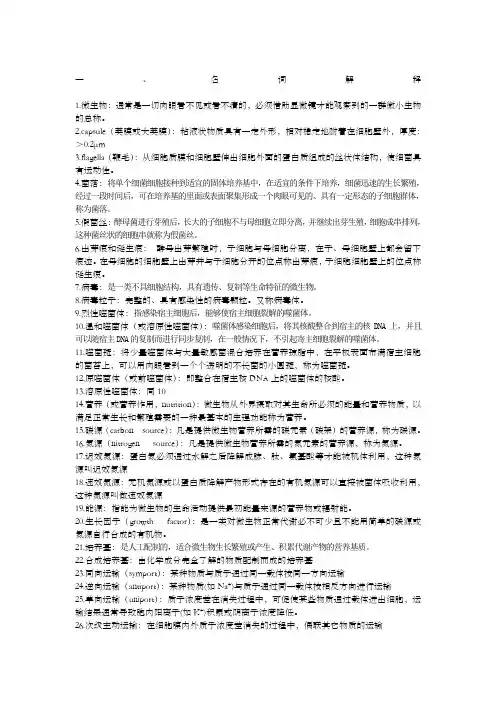
一、名词解释1.微生物:通常是一切肉眼看不见或看不清的,必须借助显微镜才能观察到的一群微小生物的总称。
2.capsule(荚膜或大荚膜):粘液状物质具有一定外形,相对稳定地附着在细胞壁外,厚度:>0.2µm3.flagella(鞭毛):从细胞质膜和细胞壁伸出细胞外面的蛋白质组成的丝状体结构,使细菌具有运动性。
4.菌落:将单个细菌细胞接种到适宜的固体培养基中,在适宜的条件下培养,细菌迅速的生长繁殖,经过一段时间后,可在培养基的里面或表面聚集形成一个肉眼可见的、具有一定形态的子细胞群体,称为菌落。
5.假菌丝:酵母菌进行芽殖后,长大的子细胞不与母细胞立即分离,并继续出芽生殖,细胞成串排列,这种菌丝状的细胞串就称为假菌丝。
6.出芽痕和诞生痕:酵母出芽繁殖时,子细胞与母细胞分离,在子、母细胞壁上都会留下痕迹。
在母细胞的细胞壁上出芽并与子细胞分开的位点称出芽痕,子细胞细胞壁上的位点称诞生痕。
7.病毒:是一类不具细胞结构,具有遗传、复制等生命特征的微生物。
8.病毒粒子:完整的、具有感染性的病毒颗粒。
又称病毒体。
9.烈性噬菌体:指感染宿主细胞后,能够使宿主细胞裂解的噬菌体。
10.温和噬菌体(或溶原性噬菌体):噬菌体感染细胞后,将其核酸整合到宿主的核DNA上,并且可以随宿主DNA的复制而进行同步复制,在一般情况下,不引起寄主细胞裂解的噬菌体。
11.噬菌斑:将少量噬菌体与大量敏感菌混合培养在营养琼脂中,在平板表面布满宿主细胞的菌苔上,可以用肉眼看到一个个透明的不长菌的小圆斑,称为噬菌斑。
12.原噬菌体(或前噬菌体):即整合在宿主核DNA上的噬菌体的核酸。
13.溶原性噬菌体:同1014.营养(或营养作用,nutrition):微生物从外界摄取对其生命所必须的能量和营养物质,以满足正常生长和繁殖需要的一种最基本的生理功能称为营养。
15.碳源(carbon source):凡是提供微生物营养所需的碳元素(碳架)的营养源,称为碳源。
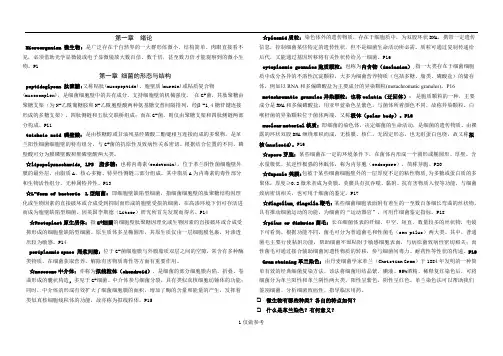
第一章绪论Microorganism 微生物: 是广泛存在于自然界的一大群形体微小、结构简单、肉眼直接看不见,必须借助光学显微镜或电子显微镜放大数百倍、数千倍,甚至数万倍才能观察到的微小生物。
P1第一章细菌的形态与结构peptidoglycan 肽聚糖:又称粘肽(mucopeptide)、胞壁质(murein)或粘质复合物(mucocomplex),是细菌细胞壁中的共有成分,支持细胞壁的机械强度。
在G+菌,其肽聚糖由聚糖支架(为N-乙酰葡糖胺和N-乙酰胞壁酸两种氨基糖交替间隔排列,经β-1,4糖苷键连接形成的多糖支架),四肽侧链和五肽交联桥组成;而在G-菌,则仅由聚糖支架和四肽侧链两部分构成。
P11teichoic acid 磷壁酸:是由核糖醇或甘油残基经磷酸二酯键相互连接而成的多聚物,是革兰阳性细菌细胞壁的特有组分,与G+菌的抗原性及致病性关系密切。
根据结合位置的不同,磷壁酸可分为膜磷壁酸和壁磷壁酸两大类。
☆lipopolysaccharide, LPS 脂多糖:也称内毒素(endotoxin),位于革兰阴性菌细胞壁外膜的最外层,由脂质A、核心多糖、特异性侧链三部分组成。
其中脂质A为内毒素的毒性部分和生物活性组分,无种属特异性。
P13☆L-form of bacteria L型细菌:即细胞壁缺陷型细菌,指细菌细胞壁的肽聚糖结构因理化或生物因素的直接破坏或合成受到抑制而形成的胞壁受损的细菌,在高渗环境下仍可存活进而成为胞壁缺陷型细菌。
因英国李斯德(Litser)研究所首先发现而得名。
P14 ☆Protoplast原生质体:指G+细菌的细胞壁肽聚糖因理化或生物因素的直接破坏或合成受抑形成的细胞壁缺陷型细菌。
原生质体多呈椭圆形,其原生质仅由一层细胞膜包裹,对渗透压较为敏感。
P14periplasmic space 周浆间隙:位于G-菌细胞膜与外膜脂质双层之间的空隙,常含有多种酶类物质,在细菌获取营养,解除有害物质毒性等方面有重要作用。
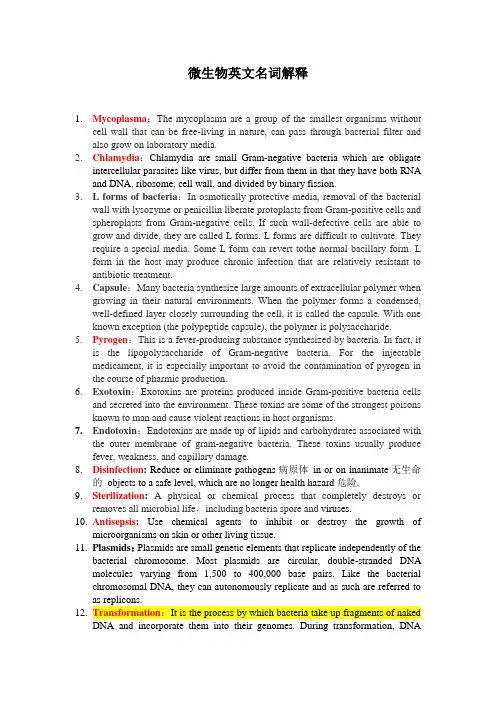
微生物英文名词解释1.Mycoplasma:The mycoplasma are a group of the smallest organisms withoutcell wall that can be free-living in nature, can pass through bacterial filter and also grow on laboratory media.2.Chlamydia:Chlamydia are small Gram-negative bacteria which are obligateintercellular parasites like virus, but differ from them in that they have both RNA and DNA, ribosome, cell wall, and divided by binary fission.3.L forms of bacteria:In osmotically protective media, removal of the bacterialwall with lysozyme or penicillin liberate protoplasts from Gram-positive cells and spheroplasts from Gram-negative cells. If such wall-defective cells are able to grow and divide, they are called L forms. L forms are difficult to cultivate. They require a special media. Some L form can revert tothe normal bacillary form. L form in the host may produce chronic infection that are relatively resistant to antibiotic treatment.4.Capsule:Many bacteria synthesize large amounts of extracellular polymer whengrowing in their natural environments. When the polymer forms a condensed, well-defined layer closely surrounding the cell, it is called the capsule. With one known exception (the polypeptide capsule), the polymer is polysaccharide.5.Pyrogen:This is a fever-producing substance synthesized by bacteria. In fact, itis the lipopolysaccharide of Gram-negative bacteria. For the injectable medicament, it is especially important to avoid the contamination of pyrogen in the course of pharmic production.6.Exotoxin:Exotoxins are proteins produced inside Gram-positive bacteria cellsand secreted into the environment. These toxins are some of the strongest poisons known to man and cause violent reactions in host organisms.7.Endotoxin:Endotoxins are made up of lipids and carbohydrates associated withthe outer membrane of gram-negative bacteria. These toxins usually produce fever, weakness, and capillary damage.8.Disinfection: Reduce or eliminate pathogens病原体in or on inanimate无生命的objects to a safe level, which are no longer health hazard危险.9.Sterilization: A physical or chemical process that completely destroys orremoves all microbial life,including bacteria spore and viruses.10.Antisepsis: Use chemical agents to inhibit or destroy the growth ofmicroorganisms on skin or other living tissue.11.Plasmids:Plasmids are small genetic elements that replicate independently of thebacterial chromosome. Most plasmids are circular, double-stranded DNA molecules varying from 1,500 to 400,000 base pairs. Like the bacterial chromosomal DNA, they can autonomously replicate and as such are referred to as replicons.12.Transformation:It is the process by which bacteria take up fragments of nakedDNA and incorporate them into their genomes. During transformation, DNAfragments from a dead degraded bacterium bind to DNA binding proteins on the surface of a competent recipient bacterium.13.Conjugation:Conjugation is the transfer of DNA directly from a living donorbacterium to a recipient bacterium during the mating of the bacteria. A sex pilus produced by the donor bacterium (or male) binds to the recipient (or female). The sex pilus then retracts, bringing the two bacteria in contact and the transferred DNA passes through the sex pilus.14.Transduction:Transduction is mediated by a bacteriophage, which pick upfragments of DNA and package them into bacteriophage particles. The DNA is delivered to infected cells and becomes incorporated into the bacterial genomes.15.Normal flora:The various bacteria and fungi that are permanent residents ofcertain body sites, especially the skin, oropharynx, colon, and vagina.16.Dysbacteriosis:If flora disequilibrium occurs, for example, when the residentflora is disturbed, some little significant microorganisms may colonize, proliferate and produce diseases, which are called dysbacteriosis. Dysbacteriosis mainly result from long term and large bacteriosis mainly result from long term and large bacteriosis mainly result from long term and large doses antibiotics taken. Antibiotics can suppress the drug-susceptible components of fecal flora.Soon thereafter the counts of fecal flora rise again to normal or higher than normal levels, principally of organisms selected out because of relative resistance to the drugs employed. The drug susceptible microorganisms are replaced by drug-resistant ones and cause correlative disease, microbial selection and substitution.17.Toxemia:Bacteria multiply at invading location and do not enter blood stream,but the exotoxins enter blood and cause corresponding toxic symptoms.18.Endotoxemia:Gram-negative bacteria multiply at location or in blood stream,release a lot of amount endotoxin released from bacterial cell rupture.19.Protein A :Protein A is a cell wall component of many S. aureus strains thatbinds to the Fc portion of IgG molecules except IgG3. The Fab portion of IgG bound to protein A is free to combine with a specific antigen. Protein A has become an important reagent in immunology and diagnostic laboratory technology; for example, protein A with attached IgG molecules directed againsta specific bacterial antigen will agglutinate bacteria that have that antigen(“coagglutination”). Protein A probably contributes to the virulence of S. aureus by interfering with opsonization.20.Elementary body(EB):Elementary body(EB)are small round cells about0.2~0.4μm with an electron-dense nucleoid. They possess a cell wall. They areextracellular form and the environmentally stable infectious particle ,and metabolically inactive. The EB have a high affinity for host epithelial cells and rapidly enter them,creating a protected membrane-bound environment around the chlamydiae,and the Elementary body is reorganized into a larger one called metabolically active Reticulate body(RB).21.Reticulate body(RB):The intracellular large form known as the reticulate bodyMeasuring about 0.5~1μm and devoid of an electron-dense nucleoid. Itspresence will reflect the stage of replication. Within the membrane-bound vacuole,the elementary grows in size and divides into repeatedly by binary fission. Eventually,the entire vacuole becomes filled with elementary bodies derived from reticulate bodies to form a cytoplasmic inclusion. The newly formed elementary bodies may be liberated from the host cell to infect new cells. The developmental cycle takes 24-48 hours.22.nucleocapsid:The simplest of virus particles consists of a protein coat (capsid)which surrounds a strand of nucleic acid and are thus called naked viruses or nucleocapsid.23.Abortive Infections:Not all infections lead to new progeny virus. Productiveinfections occur in permissive cells and result in the production of infectious virus. Abortive infections fail to produce infectious progeny, either because the cell may be nonpermissive and unable to support the expression of all viral genes or because the infecting virus may be defective, lacking some functional viral gene.24.defective virus:A defective virus is one that lacks one or more functional genesrequired for viral replication. Defective viruses require helper activity from another virus for some step in replication or maturation. One type of defective virus lacks a portion of its genome (i.e., deletion mutant). The extent of loss by deletion may vary from a short base sequence to a large amount of the genome.Deletion mutants may arise spontaneously or may be constructed in the laboratory using biochemical techniques.25.Interferons (IFN s):Interferons (IFN s)are proteins made and released by hostcells in response to the presence of pathogens such as viruses, bacteria, parasites or tumor cells. They allow for communication between cells to trigger the protective defences of the immune system that eradicate pathogens or tumors. 26.Antigenic drift: Antigenic drift is constantly occurring in both influenza A andinfluenza B viruses. The HA and/or NA of the new strain are sufficiently different to evade (at least partially) the pre-existing human immunity. This leads to the seasonal epidemics.27.Antigenic shift:Antigenic shift occurs only in influenza A virus. It describes theemergence of an entirely new virus sub type. When this new sub type emerges, it causes a pandemic because there is no pre-existing immunity in humans.。
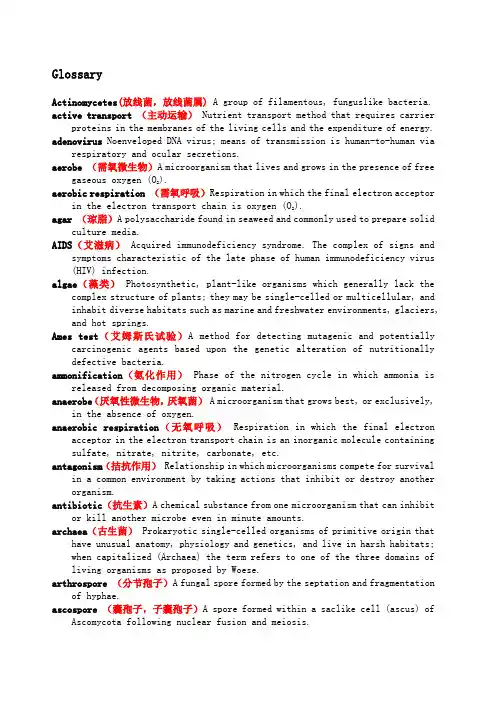
GlossaryActinomycetes(放线菌,放线菌属) A group of filamentous, funguslike bacteria. active transport (主动运输) Nutrient transport method that requires carrier proteins in the membranes of the living cells and the expenditure of energy. adenovirus Noenveloped DNA virus; means of transmission is human-to-human via respiratory and ocular secretions.aerobe(需氧微生物)A microorganism that lives and grows in the presence of free).gaseous oxygen (O2aerobic respiration(需氧呼吸)Respiration in which the final electron acceptor in the electron transport chain is oxygen (O).2agar(琼脂)A polysaccharide found in seaweed and commonly used to prepare solid culture media.AIDS(艾滋病)Acquired immunodeficiency syndrome. The complex of signs and symptoms characteristic of the late phase of human immunodeficiency virus (HIV) infection.algae(藻类) Photosynthetic, plant-like organisms which generally lack the complex structure of plants; they may be single-celled or multicellular, and inhabit diverse habitats such as marine and freshwater environments, glaciers, and hot springs.Ames test(艾姆斯氏试验)A method for detecting mutagenic and potentially carcinogenic agents based upon the genetic alteration of nutritionally defective bacteria.ammonification(氨化作用) Phase of the nitrogen cycle in which ammonia is released from decomposing organic material.anaerobe(厌氧性微生物,厌氧菌) A microorganism that grows best, or exclusively, in the absence of oxygen.anaerobic respiration(无氧呼吸)Respiration in which the final electron acceptor in the electron transport chain is an inorganic molecule containing sulfate, nitrate, nitrite, carbonate, etc.antagonism(拮抗作用)Relationship in which microorganisms compete for survival in a common environment by taking actions that inhibit or destroy another organism.antibiotic(抗生素)A chemical substance from one microorganism that can inhibit or kill another microbe even in minute amounts.archaea(古生菌) Prokaryotic single-celled organisms of primitive origin that have unusual anatomy, physiology and genetics, and live in harsh habitats;when capitalized (Archaea) the term refers to one of the three domains of living organisms as proposed by Woese.arthrospore(分节孢子)A fungal spore formed by the septation and fragmentation of hyphae.ascospore (囊孢子,子囊孢子)A spore formed within a saclike cell (ascus) of Ascomycota following nuclear fusion and meiosis.ascus(子囊) Special fungal sac in which haploid spores are created. autoclave(高压锅) A sterilization chamber which allows the use of steam under pressure to sterilize materials. The most common temperature/pressure combination for an autoclave is 121℃and 15 psi.autotroph(自养生物) A microorganism that requires only inorganic nutrients and whose sole source of carbon is carbon dioxide.Bacillus(芽孢杆菌) Bacterial cell shape that is cylindrical (longer than it is wide).back-mutation(回复突变) A mutation which counteracts an earlier mutation, resulting in the restoration of the original DNA sequence.bacteria (细菌)Category of prokaryotes with peptidoglycan in their cell wails and a single, circular chromosome. This group of small cells is widely distributed in the earth’s habitats.Bacteria (plural of bacterium) When capitalized can refer to one of the three domains of living organisms proposed by Woese, containing all non- archaea prokaryotes.bacterial chromosome 细菌染色体A circular body in bacteria that contains the primary genetic material. Also called nucleoid.Bacteriophage噬菌体A virus that specifically infects bacteria.bacterium 杆菌属A tiny unicellular prokaryotic organism that usually reproduces by binary fission and usually has a peptidoglycan cell wall, has various shapes, and can be found in virtually any environment.basidiospore(芽孢) A sexual spore that arises from a basidium. Found in basidiomycota fungi.Bdellovibrio(蛭弧菌属) A bacterium that preys on certain other bacteria. It bores a hole into a specific host and inserts itself between the protoplast and the cell wall. There it elongates before subdividing into several cells and devouring the host cell.capsule蒴果In bacteria, the loose, gel-like covering or slime made chiefly of simple polysaccharides. This layer is protective and can be associated with virulence.Chemoautotroph华能自养生物An organism that relies upon inorganic chemicals for its energy and carbon dioxide for its carbon. Also called a chemolithotroph. chemoheterotroph华能异养生物Microorganisms that derive their nutritional needs from organic compounds.chemotaxis趋化性The tendency of organisms to move in response to a chemical gradient (toward an attractant or to avoid adverse stimuli).chitin 几丁质A polysaccharide similar to cellulose in chemical structure. This polymer makes up the horny substance of the exoskeletons of arthropods and certain fungi.chromosome染色体The tightly coiled bodies in cells that are the primary sites of genes.Clone无性繁殖 A colony of cells (or group of organisms) derived from a single cell (or single organism) by asexual reproduction. All units share identical characteristics. Also used as a verb to refer to the process of producinga genetically identical population of cells or genes.colony菌落 A macroscopic cluster of cells appearing on a solid medium, each arising from the multiplication of a single cell.commensalism共栖An unequal relationship in which one species derives benefit without harming the other.conjugation结合作用In bacteria, the contact between donor and recipient cells associated with the transfer of genetic material such as plasmids. Can involve special (sex) pili. Also a form of sexual recombination in ciliated protozoans.death phase死亡期End of the cell growth due to lack of nutrition, depletion of environment, and accumulation of wastes. Population of cells begins to die.decomposition分解The breakdown of dead matter and wastes into simple compounds, that can be directed back into the natural cycle of living things. diffusion扩散The dispersal of molecules, ions, or microscopic particles propelled down aconcentration gradient by spontaneous random motion to achieve a uniform distribution.diploid 二倍体Somatic cells having twice the basic chromosome number. One set in the pair is derived from the father, and the other from the mother. direct, or total cell count 细胞计数1. Counting total numbers of individual cells being viewed with magnification. 2. Counting isolated colonies of organisms growing on a plate of media as a way to determine population size. endospore内生孢子A small, dormant, resistant derivative of a bacterial cell that germinates under favorable growth conditions into a vegetative cell.The bacterial genera Bacillus and Clostridium are typical sporeformers. eubacteria 真细菌Term used for non-archaea prokaryotes, stands for "true bacteria"eukaryotic cell真核细胞A cell that differs from a prokaryotic cell chiefly by having a nuclear membrane (a well-defined nucleus), membrane-bounded subcellular organelles, and mitotic cell division.Eukarya真核生物One of the three domains (sometimes called superkingdoms) of living organisms, as proposed by Woese; contains all eukaryotic organisms. eutrophication富营养化The process whereby dissolved nutrients resulting from natural seasonal enrichment or industrial pollution of water cause overgrowth of algae and cyanobacteria to the detriment of fishand other large aquatic inhabitants.fermentation 发酵The extraction of energy through anaerobic degradation of substrates into simpler, reduced metabolites. In large industrial processes, fermentation can mean any use of microbial metabolism to manufacture organic chemicals or other products.fimbria 菌毛A short, numerous surface appendage on some bacteria that provides adhesion but not locomotion.flagellum鞭毛A structure that is used to propel the organism through a fluid environment.gene基因A site on a chromosome that provides information for a certain cell function. A specific segment of DNA that contains the necessary code to makea protein or RNA molecule.generation time代时Time required for a complete fission cycle-from parent cell to two new daughter cells. Also called doubling time.genome 基因组染色体组The complete set of chromosomes and genes in an organism. Genotype 基因型 The genetic makeup of an organism. The genotype is ultimately responsible for an organism's phenotype, or expressed characteristics. Gram stain革兰氏染色剂 A differential stain for bacteria useful in identification and taxonomy. Gram-positive organisms appear purple from crystal violet- mordant retention, whereas gram-negative organisms appear red after loss of crystal violet and absorbance of the safranin counterstain. growth curve生长曲线A graphical representation of the change in population size over time. This graph has four periods known as lag phase, exponential or log phase, stationary phase, and death phase.growth factor生长因子An organic compound such as a vitamin or amino acid that must be provided in the diet to facilitate growth. An essential nutrient. halophile好盐菌A microbe whose growth is either stimulated by salt or requiresa high concentration of salt for growth.haploid 单倍体Having a single set of unpaired chromosomes, such as occurs in gametes and certain microbes.host 宿主Organism in which smaller organisms or viruses live, feed, and reproduce.human immunodeficiency virus (HIV)艾滋病病毒A retro virus that causes acquired immunodeficiency syndrome (AIDS).intron 内含子The segments on split genes of eucaryotes that do not code for polypeptide. They can have regulatory functions. See exon.in vitro离体 Literally means "in glass," signifying a process or reaction occurring in an artificial environment, as in a test tube or culture medium. in vivo生物体内Literally means “in a living being,” signifying a process or reaction occurring in a living thing.Koch’s postulates科赫法则 A procedure to establish the specific cause of disease. In all cases of infection: ( 1 ) The agent must be found; (2) inoculations of a pure culture must reproduce the same disease in animals;(3) the agent must again be present in the experimental animal: and (4) apure culture must again be obtained.lag phase延迟期The early phase of population growth during which no signs ofgrowth occur.L form 缺壁细菌 L-phase variants; wall-less forms of some bacteria that are induced by drugs or chemicals. These forms can be involved in infections. lipopolysaceharide 脂多糖 A molecular complex of lipid and carbohydrate found in the bacterial cell wall. The lipopolysaccharide (LPS) of gram-negative bacteria is an endotoxin with generalized pathologic effects such as fever. log phase指数期Maximum rate of cell division during which growth is geometricin its rate of increase. Also called exponential growth phase.Meiosis 减数分裂 The type of cell division necessary for producing gametes in diploid organisms. Two nuclear divisions in rapid succession produce four gametocytes, each containing a haploid number of chromosomes.minimum inhibitory concentration (MIC) 最低抑菌浓度The smallest concentration of drug needed to visibly control microbial growth.minimum temperature 最低温度 The lowest temperature at which an organism will grow.missense mutation错义突变 A mutation in which a change in the DNA sequence results in a different amino acid being incorporated into a protein, with varying results.mitosis 有丝分裂Somatic cell division that preserves the somatic chromosome number.mycelium 菌丝菌丝体The filamentous mass that makes up a mold. Composed of hyphae.Mycorrhizae 菌根Various species of fungi adapted in an intimate, mutualistic relationship to plant roots.nitrification硝化作用Phase of the nitrogen cycle in which ammonium is oxidized. nitrogen fixation固氮作用 A process occurring in certain bacteria in which atmospheric Ngas is converted to a form (NH4) usable by plants.2nonsense mutation 无义突变A mutation that changes an amino acid-producing codon into a stop codon, leading to premature termination of a protein. nucleus 细胞核The central core of an atom, composed of protons and neutrons. obligate专性Without alternative; restricted to a particular characteristic.Example: An obligate parasite survives and grows only in a host; an obligate aerobe must have oxygen to grow; an obligate anaerobe is destroyed by oxygen. optimum temperature最适温度The temperature at which a species shows the most rapid growth rate.parasite 寄生虫An organism that lives on or within another organism (the host), from which it obtains nutrients and enjoys protection. The parasite produces some degree of harm in the host.passive transport 被动运输Nutrient transport method that follows basic physical laws and does not require direct energy input from the cell. pasteurization 巴斯消毒法Heat treatment of perishable fluids such as milk, fruit juices, or wine to destroy heat-sensitive vegetative cells, followed by rapid chilling to inhibit growth of survivors and germination of spores. It prevents infection and spoilage.pathogen 病原体Any agent, usually a virus, bacterium, fungus, protozoan, or helminth, that causes disease.phage 噬菌体A bacteriophage; a virus that specifically parasitizes bacteria. phenotype表型The observable characteristics of an organism produced by the interaction between its genetic potential (genotype) and the environment. photoautotroph 光合自养生物An organism that utilizes light for its energy and carbon dioxide chiefly for its carbon needs.pill Small, stiff filamentous appendages in gram-negative bacteria that functionin DNA exchange during bacterial conjugation.plasmids质粒 Extrachromosomal genetic units characterized by several features.A plasmid is a double-stranded DNA that is smaller than and replicatesindependently of the cell chromosome; it bears genes that are not essential for cell growth; it can bear genes that code for adaptive traits; and it is transmissible to other bacteria.polysaccharide多糖 A carbohydrate that can be hydrolyzed into a number of monosaccharides. Examples: cellulose, starch, glycogen.prion朊病毒A concocted word to denote “proteinaceous infectious agent”; a cytopathic protein associated with the slow-virus spongiform encephalopathies of humans and animals.prophage 原噬菌体 A lysogenized bacteriophage; a phage that is latently incorporated into the host chromosome instead of undergoing viral replication and lysis.protoplast原生质体A bacterial cell whose cell wall is completely lacking and that is vulnerable to osmotic lysis.protozoa 原生动物A group of single-celIed, eucaryotic organisms. pseudohypha 假菌丝A chain of easily separated, spherical to sausage-shaped yeast cells partitioned by constrictions rather than by septa.pure culture 纯培养A container growing a single species of microbe whose identity is known.Retrovirus逆转录酶病毒 A group of RNA viruses (including HIV) that have the mechanisms for converting their genorne into a double strand of DNA that can be inserted on a host’s chromosome.reverse transcriptase逆转录酶The enzyme possessed by retrovimses that carries out the reversion of RNA to DNA a form of reverse transcription. rhizobia 根瘤菌Bacteria that live in plant roots and supply supplemental nitrogen that boosts plant growth.rhizosphere 根际The zone of soil, complete with microbial inhabitants, in the immediate vicinity of plant roots.rickettsias 立克次体Medically important family of bacteria, commonly carried by ticks, lice, and fleas. Significant cause of important emerging diseases. root nodules 根瘤Small growths on the roots of legume plants that arise froma symbiotic association between the plant tissues and bacteria (Rhizobia).This association allows fixation of nitrogen gas from the air into a usable nitrogen source for the plant.silent mutation同义突变 A mutation that, because of tire degeneracy of the genetic code, results in a nucleotide change in both the DNA and mRNA but not the resultant amino acid and thus, not the protein.spore孢子 A differentiated, specialized cell form that can be used for dissemination, for adverse conditions, and/or for are usually unicellular and may develop into gametes or vegetative organisms.stationary growth phase 稳定期Survival mode in which cells either stop growing or grow very slowly.sterilization 灭菌Any process that completely removes or destroys all viablemicroorganisms, including viruses, from an object or habitat. Material so treated is sterile.strict, or obligate anaerobe严格厌氧微生物An organism which does not use oxygen gas in metabolism and cannot survive in oxygen’s presence.symbiosis共生An intimate association between individuals from two species; used as a synonym for mutualism.synergism协同作用The coordinated or correlated action by two or more drugs or microbes that results in a heightened response or greater activity. temperate phage 温和噬菌体A bacteriophage that enters into a less virulent state by becoming incorporated into the host genome as a prophage instead of in the vegetative or lytic form that eventually destroys the cell.template 模板The strand in a double stranded DNA molecule which is used as a model to synthesize a complementary strand of DNA or RNA during replication or transcription.thermal death point致死温度The lowest temperature that achieves sterilization in a given quantity of broth culture upon a 10-minute exposure. Examples: 55℃for Escherichia coli, 60℃ for Mycobacterium tuberculosis, and 120℃ for spores.thermal death time热致死时间The least time required to kill all cells of a culture at a specified temperature.thermophile 嗜热生物A microorganism that thrives at a temperature of 50℃ or higher.transcription转录mRNA synthesis; the process by which a strand of RNA is produced against a DNA template.transduction转导The transfer of genetic material from one bacterium to another by means of a bacteriophage vector.transformation转化In microbial genetics, the transfer of genetic material contained in “naked” DNA fragments from a donor cell to a competent recipient cell.transposon转位子A DNA segment with an insertion sequence at each end, enabling it to migrate to another plasmid, to the bacterial chromosome, or to a bacteriophage.Vibrio弧菌A curved, rod-shaped bacterial cell.virulence 毒性In infection, the relative capacity of a pathogen to invade and harm host cells.zygospore 接合孢子A thick-walled sexual spore produced by the zygomycete fungi.It develops from the union of two hyphae, each bearing nuclei of opposite mating types.。
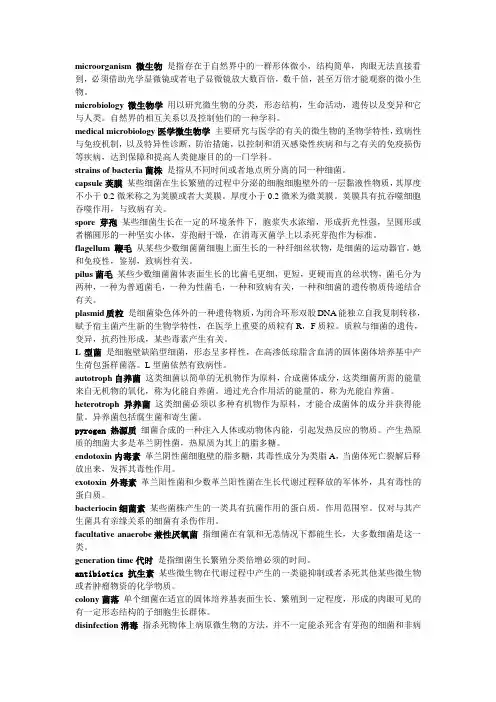
microorganism微生物是指存在于自然界中的一群形体微小,结构简单,肉眼无法直接看到,必须借助光学显微镜或者电子显微镜放大数百倍,数千倍,甚至万倍才能观察的微小生物。
microbiology微生物学用以研究微生物的分类,形态结构,生命活动,遗传以及变异和它与人类。
自然界的相互关系以及控制他们的一种学科。
medical microbiology医学微生物学主要研究与医学的有关的微生物的圣物学特性,致病性与免疫机制,以及特异性诊断,防治措施,以控制和消灭感染性疾病和与之有关的免疫损伤等疾病,达到保障和提高人类健康目的的一门学科。
strains of bacteria菌株是指从不同时间或者地点所分离的同一种细菌。
capsule荚膜某些细菌在生长繁殖的过程中分泌的细胞细胞壁外的一层黏液性物质,其厚度不小于0.2微米称之为荚膜或者大荚膜。
厚度小于0.2微米为微荚膜。
荚膜具有抗吞噬细胞吞噬作用,与致病有关。
spore芽孢某些细菌生长在一定的环境条件下,胞浆失水浓缩,形成折光性强,呈圆形或者椭圆形的一种坚实小体,芽孢耐干燥,在消毒灭菌学上以杀死芽孢作为标准。
flagellum 鞭毛从某些少数细菌菌细胞上面生长的一种纤细丝状物,是细菌的运动器官。
她和免疫性,鉴别,致病性有关。
pilus菌毛某些少数细菌菌体表面生长的比菌毛更细,更短,更硬而直的丝状物,菌毛分为两种,一种为普通菌毛,一种为性菌毛,一种和致病有关,一种和细菌的遗传物质传递结合有关。
plasmid质粒是细菌染色体外的一种遗传物质,为闭合环形双股DNA能独立自我复制转移,赋予宿主菌产生新的生物学特性,在医学上重要的质粒有R,F质粒。
质粒与细菌的遗传,变异,抗药性形成,某些毒素产生有关。
L型菌是细胞壁缺陷型细菌,形态呈多样性,在高渗低琼脂含血清的固体菌体培养基中产生荷包蛋样菌落。
L型菌依然有致病性。
autotroph自养菌这类细菌以简单的无机物作为原料,合成菌体成分,这类细菌所需的能量来自无机物的氧化,称为化能自养菌。
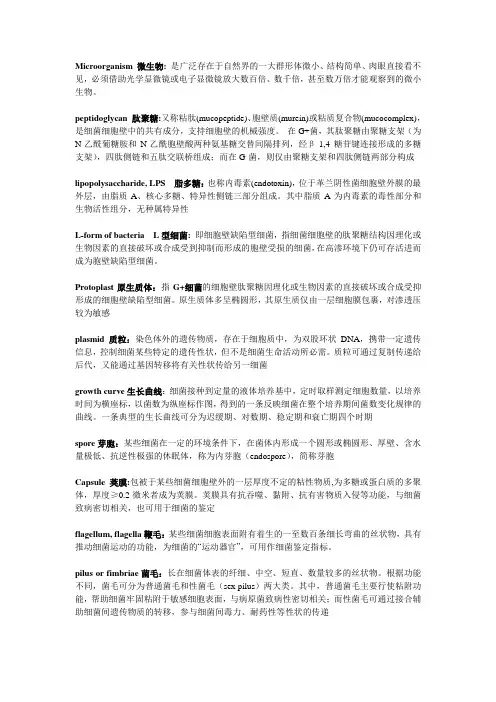
Microorganism 微生物: 是广泛存在于自然界的一大群形体微小、结构简单、肉眼直接看不见,必须借助光学显微镜或电子显微镜放大数百倍、数千倍,甚至数万倍才能观察到的微小生物。
peptidoglycan 肽聚糖:又称粘肽(mucopeptide)、胞壁质(murein)或粘质复合物(mucocomplex),是细菌细胞壁中的共有成分,支持细胞壁的机械强度。
在G+菌,其肽聚糖由聚糖支架(为N-乙酰葡糖胺和N-乙酰胞壁酸两种氨基糖交替间隔排列,经β-1,4糖苷键连接形成的多糖支架),四肽侧链和五肽交联桥组成;而在G-菌,则仅由聚糖支架和四肽侧链两部分构成lipopolysaccharide, LPS 脂多糖:也称内毒素(endotoxin),位于革兰阴性菌细胞壁外膜的最外层,由脂质A、核心多糖、特异性侧链三部分组成。
其中脂质A为内毒素的毒性部分和生物活性组分,无种属特异性L-form of bacteria L型细菌:即细胞壁缺陷型细菌,指细菌细胞壁的肽聚糖结构因理化或生物因素的直接破坏或合成受到抑制而形成的胞壁受损的细菌,在高渗环境下仍可存活进而成为胞壁缺陷型细菌。
Protoplast原生质体:指G+细菌的细胞壁肽聚糖因理化或生物因素的直接破坏或合成受抑形成的细胞壁缺陷型细菌。
原生质体多呈椭圆形,其原生质仅由一层细胞膜包裹,对渗透压较为敏感plasmid质粒:染色体外的遗传物质,存在于细胞质中,为双股环状DNA,携带一定遗传信息,控制细菌某些特定的遗传性状,但不是细菌生命活动所必需。
质粒可通过复制传递给后代,又能通过基因转移将有关性状传给另一细菌growth curve生长曲线:细菌接种到定量的液体培养基中,定时取样测定细胞数量,以培养时间为横座标,以菌数为纵座标作图,得到的一条反映细菌在整个培养期间菌数变化规律的曲线。
一条典型的生长曲线可分为迟缓期、对数期、稳定期和衰亡期四个时期spore芽胞:某些细菌在一定的环境条件下,在菌体内形成一个圆形或椭圆形、厚壁、含水量极低、抗逆性极强的休眠体,称为内芽胞(endospore),简称芽胞Capsule荚膜:包被于某些细菌细胞壁外的一层厚度不定的粘性物质,为多糖或蛋白质的多聚体,厚度≥0.2微米者成为荚膜。
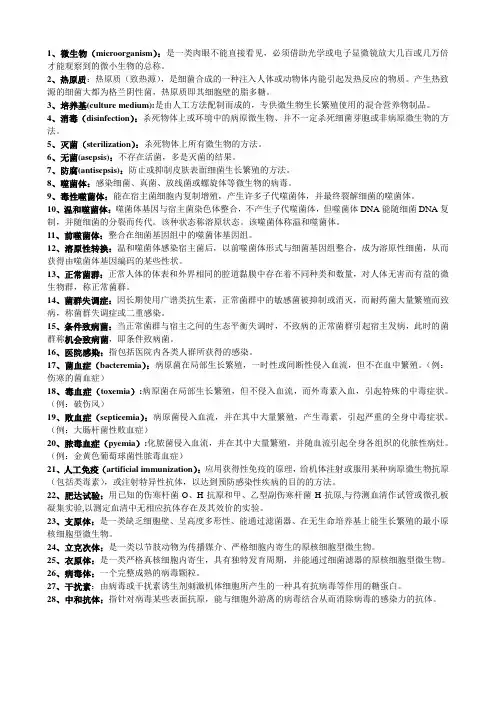
1、微生物(microorganism):是一类肉眼不能直接看见,必须借助光学或电子显微镜放大几百或几万倍才能观察到的微小生物的总称。
2、热原质:热原质(致热源),是细菌合成的一种注入人体或动物体内能引起发热反应的物质。
产生热致源的细菌大都为格兰阴性菌,热原质即其细胞壁的脂多糖。
3、培养基(culture medium):是由人工方法配制而成的,专供微生物生长繁殖使用的混合营养物制品。
4、消毒(disinfection):杀死物体上或环境中的病原微生物、并不一定杀死细菌芽胞或非病原微生物的方法。
5、灭菌(sterilization):杀死物体上所有微生物的方法。
6、无菌(asepsis):不存在活菌,多是灭菌的结果。
7、防腐(antisepsis):防止或抑制皮肤表面细菌生长繁殖的方法。
8、噬菌体:感染细菌、真菌、放线菌或螺旋体等微生物的病毒。
9、毒性噬菌体:能在宿主菌细胞内复制增殖,产生许多子代噬菌体,并最终裂解细菌的噬菌体。
10、温和噬菌体:噬菌体基因与宿主菌染色体整合,不产生子代噬菌体,但噬菌体DNA能随细菌DNA复制,并随细菌的分裂而传代。
该种状态称溶原状态。
该噬菌体称温和噬菌体。
11、前噬菌体:整合在细菌基因组中的噬菌体基因组。
12、溶原性转换:温和噬菌体感染宿主菌后,以前噬菌体形式与细菌基因组整合,成为溶原性细菌,从而获得由噬菌体基因编码的某些性状。
13、正常菌群:正常人体的体表和外界相同的腔道黏膜中存在着不同种类和数量,对人体无害而有益的微生物群,称正常菌群。
14、菌群失调症:因长期使用广谱类抗生素,正常菌群中的敏感菌被抑制或消灭,而耐药菌大量繁殖而致病,称菌群失调症或二重感染。
15、条件致病菌:当正常菌群与宿主之间的生态平衡失调时,不致病的正常菌群引起宿主发病,此时的菌群称机会致病菌,即条件致病菌。
16、医院感染:指包括医院内各类人群所获得的感染。
17、菌血症(bacteremia):病原菌在局部生长繁殖,一时性或间断性侵入血流,但不在血中繁殖。
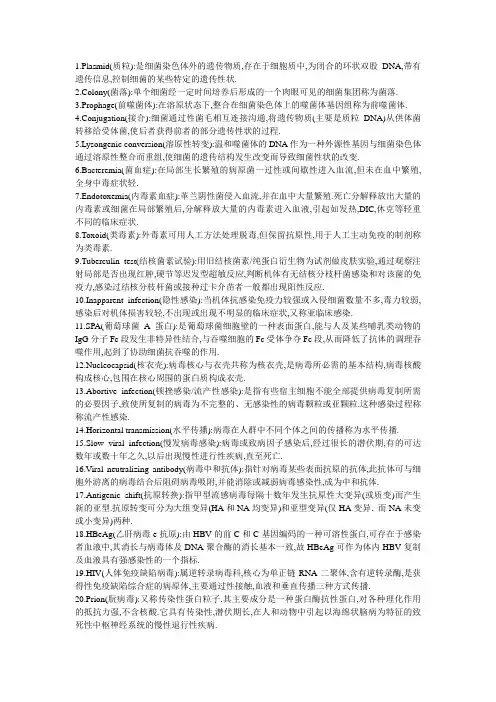
1.Plasmid(质粒):是细菌染色体外的遗传物质,存在于细胞质中,为闭合的环状双股DNA,带有遗传信息,控制细菌的某些特定的遗传性状.2.Colony(菌落):单个细菌经一定时间培养后形成的一个肉眼可见的细菌集团称为菌落.3.Prophage(前噬菌体):在溶原状态下,整合在细菌染色体上的噬菌体基因组称为前噬菌体.4.Conjugation(接合):细菌通过性菌毛相互连接沟通,将遗传物质(主要是质粒DNA)从供体菌转移给受体菌,使后者获得前者的部分遗传性状的过程.5.Lysongenic conversion(溶原性转变):温和噬菌体的DNA作为一种外源性基因与细菌染色体通过溶原性整合而重组,使细菌的遗传结构发生改变而导致细菌性状的改变.6.Bacteremia(菌血症):在局部生长繁殖的病原菌一过性或间歇性进入血流,但未在血中繁殖,全身中毒症状轻.7.Endotoxemia(内毒素血症):革兰阴性菌侵入血流,并在血中大量繁殖.死亡分解释放出大量的内毒素或细菌在局部繁殖后,分解释放大量的内毒素进入血液,引起如发热,DIC,休克等轻重不同的临床症状.8.Toxoid(类毒素):外毒素可用人工方法处理脱毒,但保留抗原性,用于人工主动免疫的制剂称为类毒素.9.Tuberculin test(结核菌素试验):用旧结核菌素/纯蛋白衍生物为试剂做皮肤实验,通过观察注射局部是否出现红肿,硬节等迟发型超敏反应,判断机体有无结核分枝杆菌感染和对该菌的免疫力,感染过结核分枝杆菌或接种过卡介苗者一般都出现阳性反应.10.Inapparent infection(隐性感染):当机体抗感染免疫力较强或入侵细菌数量不多,毒力较弱,感染后对机体损害较轻,不出现或出现不明显的临床症状,又称亚临床感染.11.SPA(葡萄球菌A蛋白):是葡萄球菌细胞壁的一种表面蛋白,能与人及某些哺乳类动物的IgG分子Fc段发生非特异性结合,与吞噬细胞的Fc受体争夺Fc段,从而降低了抗体的调理吞噬作用,起到了协助细菌抗吞噬的作用.12.Nucleocapsid(核衣壳):病毒核心与衣壳共称为核衣壳,是病毒所必需的基本结构,病毒核酸构成核心,包围在核心周围的蛋白质构成衣壳.13.Abortive infection(顿挫感染/流产性感染):是指有些宿主细胞不能全部提供病毒复制所需的必要因子,致使所复制的病毒为不完整的、无感染性的病毒颗粒或亚颗粒.这种感染过程称称流产性感染.14.Horizontal transmission(水平传播):病毒在人群中不同个体之间的传播称为水平传播.15.Slow viral infection(慢发病毒感染):病毒或致病因子感染后,经过很长的潜伏期,有的可达数年或数十年之久,以后出现慢性进行性疾病,直至死亡.16.Viral neutralizing antibody(病毒中和抗体):指针对病毒某些表面抗原的抗体,此抗体可与细胞外游离的病毒结合后阻碍病毒吸附,并能消除或减弱病毒感染性,成为中和抗体.17.Antigenic shift(抗原转换):指甲型流感病毒每隔十数年发生抗原性大变异(或质变)而产生新的亚型.抗原转变可分为大组变异(HA和NA均变异)和亚型变异(仅HA变异.而NA未变或小变异)两种.18.HBeAg(乙肝病毒e抗原):由HBV的前C和C基因编码的一种可溶性蛋白,可存在于感染者血液中,其消长与病毒体及DNA聚合酶的消长基本一致,故HBeAg可作为体内HBV复制及血液具有强感染性的一个指标.19.HIV(人体免疫缺陷病毒):属逆转录病毒科,核心为单正链RNA二聚体,含有逆转录酶,是获得性免疫缺陷综合症的病原体,主要通过性接触,血液和垂直传播三种方式传播.20.Prion(朊病毒):又称传染性蛋白粒子.其主要成分是一种蛋白酶抗性蛋白,对各种理化作用的抵抗力强,不含核酸.它具有传染性,潜伏期长,在人和动物中引起以海绵状脑病为特征的致死性中枢神经系统的慢性退行性疾病.21.Widal test(肥达氏试验):系用已知的伤寒杆菌O、H抗原和甲、乙型副伤寒杆菌的H抗原,与不同稀释度的待检血清作定量凝集试验,根据抗体的含量和动态变化以辅助临床诊断伤寒、副伤寒的一种血清学试验.22.IMViC test(IMViC试验):吲哚试验(I),甲基红试验(M)、VP试验(V)、柠檬酸试验(C)四种试验常用于肠道杆菌的鉴别,合称IMViC试验.23.TAT(破伤风抗毒素):能中和破伤风毒素的特异性抗体.主要用于破伤风感染的治疗和紧急预防.。
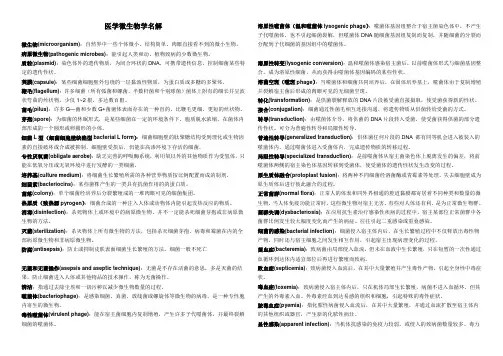
医学微生物学名解微生物(microorganism):自然界中一些个体微小、结构简单、肉眼直接看不到的微小生物。
病原微生物(pathogenic microbes):能引起人类和动、植物致病的少数微生物。
质粒(plasmid):染色体外的遗传物质,为闭合环状的DNA,可携带遗传信息,控制细菌某些特定的遗传性状。
荚膜(capsule):某些细菌细胞壁外包绕的一层黏液性物质,为蛋白质或多糖的多聚体。
鞭毛(flagellum):许多细菌(所有弧菌和螺菌,半数杆菌和个别球菌)菌体上附有的细长并呈波状弯曲的丝状物,少仅1~2根,多达数百根。
菌毛(pilus):许多G—菌和少数G+菌菌体表面存在的一种直的、比鞭毛更细、更短的丝状物。
芽孢(spore):为细菌的休眠形式,是某些细菌在一定的环境条件下,胞质脱水浓缩,在菌体内部形成的一个圆形或卵圆形的小体。
细菌L型(细菌细胞壁缺陷型bacterial L form):细菌细胞壁的肽聚糖结构受到理化或生物因素的直接破坏或合成被抑制,细胞壁受损后,仍能在高渗环境下存活的细菌。
专性厌氧菌(obligate aerobe):缺乏完善的呼吸酶系统,利用氧以外的其他物质作为受氢体,只能在低氧分压或无氧环境中进行发酵的一类细菌。
培养基(culture medium):将细菌生长繁殖所需的各种营养物质按比例配置而成的制剂。
细菌素(bacteriocins):某些菌株产生的一类具有抗菌作用的的蛋白质。
菌落(colony):单个细菌经培养后分裂繁殖成的一堆肉眼可见的细菌集团。
热原质(致热源pyrogen):细菌合成的一种注入人体或动物体内能引起发热反应的物质。
消毒(disinfection):杀死物体上或环境中的病原微生物、并不一定能杀死细菌芽孢或非病原微生物的方法。
灭菌(sterilization):杀灭物体上所有微生物的方法,包括杀灭细菌芽孢、病毒和霉菌在内的全部病原微生物和非病原微生物。
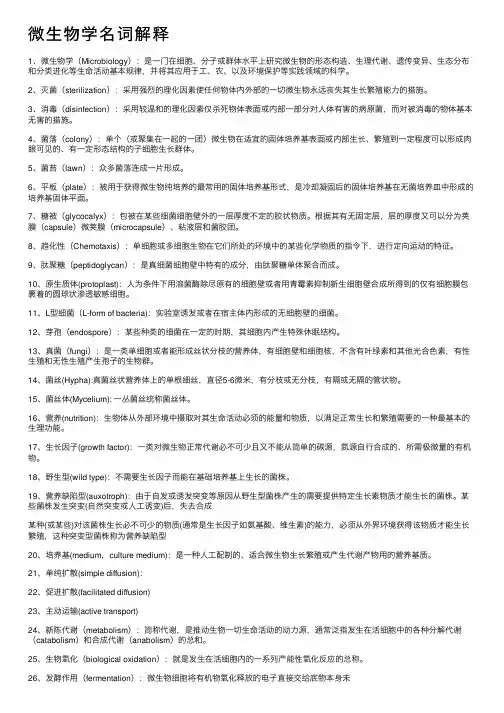
微⽣物学名词解释1、微⽣物学(Microbiology):是⼀门在细胞、分⼦或群体⽔平上研究微⽣物的形态构造、⽣理代谢、遗传变异、⽣态分布和分类进化等⽣命活动基本规律,并将其应⽤于⼯、农、以及环境保护等实践领域的科学。
2、灭菌(sterilization):采⽤强烈的理化因素使任何物体内外部的⼀切微⽣物永远丧失其⽣长繁殖能⼒的措施。
3、消毒(disinfection):采⽤较温和的理化因素仅杀死物体表⾯或内部⼀部分对⼈体有害的病原菌,⽽对被消毒的物体基本⽆害的措施。
4、菌落(colony):单个(或聚集在⼀起的⼀团)微⽣物在适宜的固体培养基表⾯或内部⽣长、繁殖到⼀定程度可以形成⾁眼可见的、有⼀定形态结构的⼦细胞⽣长群体。
5、菌苔(lawn):众多菌落连成⼀⽚形成。
6、平板(plate):被⽤于获得微⽣物纯培养的最常⽤的固体培养基形式,是冷却凝固后的固体培养基在⽆菌培养⽫中形成的培养基固体平⾯。
7、糖被(glycocalyx):包被在某些细菌细胞壁外的⼀层厚度不定的胶状物质。
根据其有⽆固定层,层的厚度⼜可以分为荚膜(capsule)微荚膜(microcapsule)、粘液层和菌胶团。
8、趋化性(Chemotaxis):单细胞或多细胞⽣物在它们所处的环境中的某些化学物质的指令下,进⾏定向运动的特征。
9、肽聚糖(peptidoglycan):是真细菌细胞壁中特有的成分,由肽聚糖单体聚合⽽成。
10、原⽣质体(protoplast):⼈为条件下⽤溶菌酶除尽原有的细胞壁或者⽤青霉素抑制新⽣细胞壁合成所得到的仅有细胞膜包裹着的圆球状渗透敏感细胞。
11、L型细菌(L-form of bacteria):实验室诱发或者在宿主体内形成的⽆细胞壁的细菌。
12、芽孢(endospore):某些种类的细菌在⼀定的时期,其细胞内产⽣特殊休眠结构。
13、真菌(fungi):是⼀类单细胞或者能形成丝状分枝的营养体,有细胞壁和细胞核,不含有叶绿素和其他光合⾊素,有性⽣殖和⽆性⽣殖产⽣孢⼦的⽣物群。
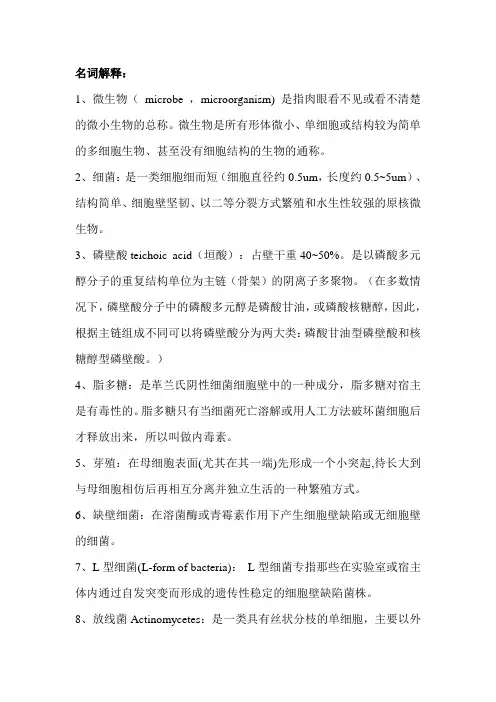
名词解释:1、微生物(microbe ,microorganism) 是指肉眼看不见或看不清楚的微小生物的总称。
微生物是所有形体微小、单细胞或结构较为简单的多细胞生物、甚至没有细胞结构的生物的通称。
2、细菌:是一类细胞细而短(细胞直径约0.5um,长度约0.5~5um)、结构简单、细胞壁坚韧、以二等分裂方式繁殖和水生性较强的原核微生物。
3、磷壁酸teichoic acid(垣酸):占壁干重40~50%。
是以磷酸多元醇分子的重复结构单位为主链(骨架)的阴离子多聚物。
(在多数情况下,磷壁酸分子中的磷酸多元醇是磷酸甘油,或磷酸核糖醇,因此,根据主链组成不同可以将磷壁酸分为两大类:磷酸甘油型磷壁酸和核糖醇型磷壁酸。
)4、脂多糖:是革兰氏阴性细菌细胞壁中的一种成分,脂多糖对宿主是有毒性的。
脂多糖只有当细菌死亡溶解或用人工方法破坏菌细胞后才释放出来,所以叫做内毒素。
5、芽殖:在母细胞表面(尤其在其一端)先形成一个小突起,待长大到与母细胞相仿后再相互分离并独立生活的一种繁殖方式。
6、缺壁细菌:在溶菌酶或青霉素作用下产生细胞壁缺陷或无细胞壁的细菌。
7、L型细菌(L-form of bacteria):L型细菌专指那些在实验室或宿主体内通过自发突变而形成的遗传性稳定的细胞壁缺陷菌株。
8、放线菌Actinomycetes:是一类具有丝状分枝的单细胞,主要以外生孢子的形式繁殖,革兰氏阳性,与细菌同属原核微生物。
放线菌菌落中的菌丝常从一个中心向四周辐射状呈放射状生长,并因此而得名。
放线菌有特殊的土霉味。
9、菌丝(hyphae):具有G+菌细胞壁丝状细胞,没有间隔,为多核体。
可分为基内菌丝、气生菌丝和孢子丝。
成团的菌丝为菌丝体。
10、基内菌丝(substrate hyphae): 培养基内匍匐生长的菌丝,无隔,约0.2-0.8μm。
通常会产生水溶性或脂溶性色素。
功能:吸收营养,所以又称营养菌丝。
11、气生菌丝(aerial hyphae):由营养菌丝长出培养基外,伸向空间的菌丝。
1微生物(microorganism)是一群体积微小、结构简单,肉眼不能直接看到,必须借助显微镜才能观察到的微小生物的总称。
1.周浆间隙:位于革兰阴性菌细胞膜与外膜的脂质双层之间,含有多种蛋白酶、核酸酶、解毒酶及特殊结合蛋白,在细菌获得营养、解除有害物质毒性方面具有重要作用。
2.细菌L型:细菌细胞壁的肽聚糖结构受到理化或生物因素作用被破坏或合成被抑制,在高渗环境下仍然能够生长和分裂者。
3.正常菌群:在正常情况下,人体的体表及其与外界相通的腔道都有一定种类和数量的微生物寄生,这些微生物通常对人体是无害的,甚至有益,故成为正常微生物或正常菌群。
4.菌群失调:正常菌群发生定性和定量的改变,由生理性组合转变为病理性组合。
5.异染颗粒:许多细菌含有储藏高能磷酸键的多聚偏磷酸盐颗粒。
1.真菌:是一类有典型细胞核和完整细胞器,无根、茎、叶,不含叶绿素的一类真核细胞型微生物。
2.菌丝:真菌在适宜环境中,由成熟孢子出芽长出芽管,芽管逐渐延长后形成的丝状结构。
3.单细胞真菌:圆形或椭圆形,以芽生方式繁殖,其菌落与细菌的菌落相似。
如酵母型、、类酵母型真菌4.孢子:是真菌的生殖结构,由生殖菌丝产生的。
大多数真菌是通过各种有性或无性的孢子繁殖的,也是真菌鉴定和分类的主要依据。
1.病毒:是一类个体微小,结构简单,只有一种类型核酸,严格活细胞内寄生的非细胞型微生物。
2.病毒体: 具有典型的形态结构,有感染性,完整的病毒颗粒。
3.顿挫感染:宿主细胞不能为病毒增殖提供所需要的酶、能量及必要的成分,则病毒在其中不能复制称为顿挫感染。
4.缺陷病毒:基因组不完整或因基因某一点改变而不能进行正常增殖的病毒。
5.灭活:从细胞中释放的病毒体受外界理化因素因素作用后,失去感染性。
6. 干扰现象:两种病毒感染同一细胞时,可发生一种病毒抑制另一种病毒增殖的现象称为干扰现象。
1.侵袭力:病原微生物能突破宿主的防御机制,在机体内定植、繁殖和扩散的能力。
微生物名词解释1.微生物(microorganism):是一类个体微小,构造简单,人眼不能看见,需借助显微镜才能看清楚外形的微小生物。
2.微生物学(microbiology):是研究微生物的形态结构,生理代谢,遗传变异,生态分布,以及与人类、动植物自然界相互关系的一门学科。
3.支原体(mycoplasma):是一类无细胞壁,能在无生命的人工培养基中生长繁殖的最小原核细胞型微生物。
4.衣原体(chamydiae):是一类专性细胞内寄生的原核细胞型微生物。
5.立克次体(rickettsiae):是一类专性细胞内寄生的原核细胞型微生物。
6.干扰素(interferon):是机体细胞受病毒感染或其他干扰素诱生剂作用下,有细胞基因组控制产生的一类蛋白质,具有抗病毒增值等多种生物活性。
7.灭菌(sterilization):利用理化方法,杀死物体或介质中的所有微生物包括致病的和非致病各种微生物,以及细菌的芽孢。
灭菌后物品即成无菌状态。
8.消毒(disinfection):利用理化方法,杀死物体或介质中的病原微生物,但不一定杀死芽孢。
通过消毒可以防止病原微生物传播的目的。
9.质粒(plasmid):是染色体能够进行自主复制的遗传物质。
10.突变(mutation):是遗传基因在结构上发生突然而稳定的改变,从而导致性状发生遗传性变异。
11.基因突变(gene mutation):常是DNA中一对或邵书记对碱基的置换、增加或缺失。
12.转化(transformation):是指受体菌直接从环境中吸收供体菌游离的DNA片段,并整合入受体菌基因组中,从而获得了供体菌部分遗传性状的过程。
13.感受态(competence):是指受体菌能够从周围环境中吸收外源DNA分子,并进行转化的生理状态。
14.接合(conjugation):在供体菌与受体菌直接接触情况下,通过性菌毛的作用,遗传物质从供体菌转移至受体菌内,这种方式称为接合。
名词解释1.微生物(microorganism,microbe):是一类存在于自然界肉眼不能直接看到,必须借助光学显微镜或电子显微镜放大几百倍乃至几万倍才能观察到的微小生物的总称。
2.正常菌群(normal flora):存在于正常人和动物皮肤和粘膜表面的一定数量和一定种类的微生物群。
3.医学微生物(medical microorganism):主要研究病原微生物的生物学性状、致病性和免疫性、微生物学检查法、防治原则一门学科。
4.细菌(bacterium):是一类具有细胞壁的二分裂增殖的单细胞原核生物。
5.中介体(mesosome):是部分细胞膜内陷、折叠、卷曲形成的囊状物,多见于G+菌,与细菌分裂及呼吸有关(拟线粒体)。
6.质粒(plasmid):核质外的遗传物质,双股环状DNA。
7.荚膜(capsule):某些细菌细胞壁外包绕的一层粘液性物质,多糖或多肽。
8.鞭毛(flagella):附着于菌体的细长并呈波状弯曲的丝状物。
9.芽孢(spore, endospore):在菌体内形成的圆形或椭圆形小体,是细菌的休眠形式,带有细菌全部生命活动的必须物质。
10.缺陷病毒(defective virus):由于病毒基因组不完整或基因位点改变,病毒单独在宿主细胞内不能合成病毒所需的全部成分,因此不能增殖成为有感染性的病毒颗粒,称为缺陷病毒。
11.病毒干扰现象(viral interference):两种病毒同时或先后感染同一宿主细胞时,可发生一种病毒抑制另一种病毒增殖的现象,称为病毒干扰现象。
12.消毒(disinfection):杀灭物体或环境中病原微生物的方法,但不一定杀死非病原菌和芽胞。
13.灭菌(sterilization):杀灭物体上所有微生物的方法。
14.防腐(antisepsis):防止或抑制体外细菌生长繁殖的方法,但不一定杀死细菌。
15.无菌(asepsis):在指定环境中无活菌的意思。
一Microorganism/microbe:(微生物)所有形体微小,单细胞或个体结构简单的多细胞,生殖无细胞结构的低级生物的总称二colony: (菌落)单个细菌大量繁殖后,可在适宜的固体培养基表面或内部形肉眼可见的,有一定形态结构的子细胞群体。
Lawn:(菌苔)多个菌落连成一片LPS:(脂多糖)G-细胞壁中重要成分,有O特异多糖核心多糖与内脂A组成Protoplast (原生质体)G+在人为条件下,用溶菌酶除去原有细胞壁或用青霉素阻止新细胞壁合成,得到的仅有细胞膜包裹的球状渗透敏感细胞L-form of bacteria:(L型细菌)细菌在某种环境条件下(或实验室条件下)通过自发突变形成的遗传稳定的细胞壁缺陷变异型Mycoplasma: (支原体)由于长期进化过程中形成的,适应自然环境的无细胞壁原核生物。
PHB (聚β羟丁酸)原核生物中最常见的内含物之一由β羟丁酸单体组成的类似于脂类的碳源类贮藏物。
Flagellum (鞭毛)菌体表面着生的一根或数根又细又长的,螺旋形丝状附属物Fimbriae (菌毛):细胞表面生出的比鞭毛更短,更细,更多的丝状结构Endospore (芽孢)某些细菌在其生长发育后期,形成的圆形或椭圆形,壁厚,含水量极低,抗逆性极强的休眠体Actinomycetes (放线菌):一类以菌丝生长,分生孢子繁殖,具高G+C含量的革兰氏阳性陆生性很强的原核生物Cyanobacterium (蓝细菌): 含叶绿素a,进行放氧型光合作用的原核生物Spirochete/spirochaete (螺旋菌)具有独特形态结构和运动机制的特殊的革兰氏阴性菌Rickettsia 一类介于细胞和病毒之间,以节肢动物为媒介的,专性细胞内寄生的革兰氏阴性菌Chlamydia (衣原体)一类介于立克次氏体与病毒之间,可以通过细菌滤器,真核细胞内严格专性能量寄生的革兰氏阴性原核生物原体有病原性Archaea (古生菌)独立于细菌与真核生物之外的第三种生命形式三Fungi (真菌)具有真正细胞核;通常有分支繁茂的丝状体,菌丝呈顶端生长;细胞壁坚硬,含有几丁质与葡聚糖,少数含纤维素;以无性孢子和有性孢子进行繁殖,营养方式为化能异养好氧Mold (霉菌)一些丝状真菌的总称,通常指菌丝体发达又不产生大型肉质子实体的真菌Chlamydospore (厚垣孢子)菌丝中不规则而肥大的菌丝细胞,不良环境下,原生质体收缩,变圆,外面形成厚壁,用以抵御不良环境,表面一般具有刺状或瘤状突起Haustorium (吸器)许多植物寄生真菌的菌丝体生长在寄主表面,从菌丝发生旁支侵入寄主细胞吸取养料。
名词解释1.微生物:一大群形体微小、结构简单、一般肉眼看不见或看不清楚的微小生物的总称。
2.微生物学microbiology病毒:类病毒,拟病毒,朊病毒原核:真细菌,古生菌真核:真菌(酵母菌,霉菌),单细胞藻类,原生动物1.培养物culture:在人为规定的条件下培养、繁殖得到的微生物群体。
2.纯培养物pure culture:只有一种微生物的培养物3.混合培养物:含有多种微生物的培养物。
4.菌落:单个(或聚集在一起的一团)微生物在适宜的固体培养基表面或内部生长、繁殖到一定程度可以形成肉眼可见的、有一定形态结构的子细胞生长群体。
5.无菌技术:在分离、转接及培养纯培养物时防止其被其他微生物污染,其自身也不污染环境的技术。
6.培养基culture medium:培养微生物的营养物质人工配制、适合微生物生长繁殖或产生代谢产物的营养基质。
7.二元培养物:培养物中只含有二种微生物,而且是有意识的保持二者之间的特定关系的培养物。
8.分辨率:能辨别两点之间最小距离的能力。
9.古生菌:在分类地位上与真细菌和真核生物列为第三域,并且在进化谱上更接近真核生物;没有核膜、核仁,在细胞构造上与真细菌较为接近,同属原核生物;多生活于一些团结十分恶劣的极端环境中,如高温、高盐、高酸等。
(与细菌具有类似的个体形态,多生活于一些生存条件十分恶劣的极端环境中,如高盐、高温、高酸。
)10.霉菌:一些丝状真菌的统称,不是分类学上的名词,霉菌菌体均由分支或不分支的菌丝构成,许多菌丝交织在一起,称为菌丝体。
11.菌丝(Hypha)霉菌营养体的基本单位12.由许多分枝菌丝相互交织而成的一个菌丝集团,称为菌丝体菌丝体(Mycelium)13.酵母菌:一群单细胞的真核微生物,无分类学意义的普通名称,通常以芽殖或裂殖来进行无性繁殖的单细胞真菌,以与霉菌分开。
极少数种可产生子囊孢子进行有性繁殖。
14.原核微生物:一大类细胞微小、细胞核无核膜包裹(只有称作核区的裸露DNA)的原始单细胞生物。
—、名词解释1.normal flora:即正常菌群,在人的体表或与外界相通的腔道存在着不同种类和一定数量的细菌,通常对人有益无害,故称正常菌群.2.disinfection:即消毒,杀死病原微生物的方法.3.bacterium:即细菌,是一种体积微小,结构简单,具有原始细胞核和不完善的细胞器的单细胞的原核细胞型微生物.4.肽聚糖:细菌细胞壁的成分,由聚糖骨架、四肽侧链及五肽交连桥(革兰阳性菌具有)构成.5.转导:以温和噬菌体为媒介,将供体菌的一段DNA转移到受体菌内,使受体菌获得新的性状.6.细菌L型:在青霉素或溶菌酶作用下,细菌细胞壁的肽聚糖被破坏或合成受抑制,而形成的细胞壁缺陷型细菌,因最先在Lister研究所发现,故称.7.热原质:细菌合成的一种注入人体或动物体内能引起发热反应的物质.8.菌落:平板培养基上,单个细菌生长后形成的肉眼可见的细菌集团.9.噬菌体:感染细菌、真菌、放线菌和螺旋体等微生物的病毒.10.高压蒸汽灭菌法:在103.43kPa蒸汽压下,温度达到121.3℃,维持15~20min,可杀灭包括细菌芽胞在内的所有微生物.常用于耐高温、耐湿物品的灭菌.11.异染颗粒:白喉棒状杆菌的胞质中存在的胞质颗粒,用特殊染色后,可呈现与菌体明显不一样的颜色,称为异染颗粒.12.卡介苗:Calmette和Guérin将牛结核分枝杆菌经1.3年2.30次传代培养而获得的减毒活疫苗株,用于预防结核病.13.卫星现象:将流感嗜血杆菌与金黄色葡萄球菌共同接种在兔血平板上,金黄色葡萄球菌菌落周围的流感嗜血杆菌菌落较大,离金葡菌菌落越远的越小,此现象称为卫星现象.14.血浆凝固酶试验:金黄色葡萄球菌产生的一种侵袭性酶,使血浆中的纤维蛋白原转化为纤维蛋白,引起血浆凝固.15.肥达反应:用已知伤寒沙门菌O抗原和H抗原,及引起副伤寒的甲型副伤寒沙门菌\肖氏沙门菌和希氏沙门菌H抗原的诊断菌液与受检血清做定量凝集试验,测定受检血清中有无相应抗体及其效价的试验.16.巧克力平板:即热血平板,血平板加热80℃1.5min而制成,因其呈巧克力色而得名.17.串珠试验:炭疽芽胞杆菌在含微量青霉素的培养基上,其形态变异为大而均匀的圆球形,呈串珠状排列.是炭疽芽胞杆菌的重要鉴定试验.18.医院内感染:一切在医院内活动的人群(主要为住院病人)在医院内或病人在住院期间或出院后不久发生的感染以及与前次住院有关的感染.19.标准菌株:具有某种细菌典型而稳定的生物学特征且被国际认可的菌株.20.病毒包涵体:病毒感染细胞后,在胞浆或胞核内出现的嗜酸性或嗜碱性的包块.21.内基小体:狂犬病毒在易感动物或人的中枢神经细胞中增殖时,在胞质中形成的嗜酸性包涵体.22.干扰现象:两种病毒感染同一细胞时,会出现一种病毒抑制另一种病毒增殖的现象.23.CPE:即细胞病变效应,病毒感染细胞后,细胞所出现的浓缩、深染、胞质不均匀等一系列变化.24.Dane颗粒:具有感染性的完整的乙肝病毒颗粒.25.支原体:无细胞壁,能通过滤菌器,可人工培养的最小最简单的原核细胞型微生物.26.显微镜凝集试验:以标准的活钩体作为抗原,与不同稀释度的患者血清孵育,暗视野显微镜检查有无凝集现象.27.双相型真菌:在沙氏培养基中2.5℃培养形成丝状菌落,37℃培养形成酵母样菌落的一类真菌.28.conditioned pathegen:即条件致病菌,通常不致病,在特定条件引起感染的细菌.29.sterilization:即灭菌,杀死所有微生物的方法,包括病原微生物和非病原微生物,繁殖体和芽苞.30.侵袭力:病原菌突破机体的防御机能,在体内定居、生长繁殖、蔓延扩散的能力.31.LPS:即脂多糖,G-菌细胞壁特有的成分,由脂质A,核心多糖和特异性多糖组成,是细菌的内毒素.32.转化:受体菌直接摄取供体菌游离的DNA片段而获得新的性状.33.细菌:是一种体积微小,结构简单,具有原始细胞核和不完善的细胞器的单细胞的原核细胞型微生物.34.细菌素:细菌所产生的能抑制同种细菌增殖的蛋白质.35.专性厌氧菌:只能在无氧条件生长的细菌.36.噬菌体:感染细菌、真菌、放线菌和螺旋体等微生物的病毒.37.芽胞:细菌细胞壁外包围的一层由疏水性多糖或蛋白质多聚体组成的黏液性物质结构.38.ASO:SLO抗原性强,链球菌侵入体内产生SLO, 2~3周刺激机体产生相应抗体ASO,维持数月至1年,其效价>1:400可做为风湿热及其活动性的辅助诊断.39.BCG:即卡介苗,Calmette和Guérin将牛分枝杆菌经13年230次传代而获得的减毒活疫苗株,用于预防结核病.40.迁徙生长现象:变形杆菌在固体培养基上呈扩散性生长,形成以菌接种部位为中心的厚薄交替、同心圆形的层层波状菌苔.41.非发酵菌:一大群不发酵葡萄糖或仅以氧化形式利用葡萄糖的无芽胞的G-杆菌.42.汹涌发酵现象:产气荚膜梭菌能分解牛乳培养基中的乳糖产酸,使其中的酪蛋白凝固;同时产生大量气体,可将凝固的酪蛋白冲成蜂窝状,把液面凝固的凡士林层向上推,甚至冲走试管塞,称为汹涌发酵现象.43.热血平板:即巧克力平板,血平板加热80℃15min而制成.44.Ascol热沉淀反应:炭疽芽胞杆菌的菌体多糖抗原耐热,耐腐败,在病兽腐败脏器或皮毛经长时间煮沸仍可与相应血清发生沉淀反应.45.inclusion body:即包涵体,病毒感染细胞后,在胞浆或胞核内出现的嗜酸性或嗜碱性的包块.46.Negri body:即内基小体,狂犬病毒在易感动物或人的中枢神经细胞中增殖时,在胞质中形成的嗜酸性包涵体.47.病毒的灭活:病毒失去感染性.48.Antigenic drift:抗原发生小的变异49.干扰素:病毒或其他干扰素诱生剂刺激人或动物细胞所产生的一种分泌性蛋白,具有抗病毒、抗肿瘤和免疫调节作用.50.HA:即血凝素,流感病毒包膜上的刺突,具有凝集红细胞的作用.51.逆转录病毒:RNA病毒在复制时,通过DNA中间体,并与细胞染色体整合.52.螺旋体:一类细长柔软弯曲呈螺旋状的原核细胞型微生物.53.朊粒:仅存在于感染动物的组织中、具有致病性与传染性、对蛋白酶K有抗性的特殊蛋白质.54.孢子:真菌的繁殖结构,由生殖菌丝产生.55.外毒素:主要由G+菌和部分G-菌产生并释放到菌体外的毒性蛋白质.56.disinfection:即消毒,杀死病原微生物的方法.57.plasmid:即质粒,细菌染色体外的遗传物质,存在细胞质中的环状DNA分子58.荚膜:细菌细胞壁外包围的一层由疏水性多糖或蛋白质多聚体组成的黏液性物质结构.具有抗吞噬、粘附及抗有害物质损伤的作用.59.接合:是细菌通过性菌毛相互连接沟通,将遗传物质(主要是质粒DNA)从供体菌转移给受体菌.60.中介体:部分细胞膜内陷、折叠、卷曲形成的囊状物,与细菌分裂有关,为细菌提供大量能量.61.吲哚试验:有些细菌如大肠埃希菌,能分解培养基中的色氨酸生成无色的吲哚,其可与对半-氨基苯甲醛反应生成红色的玫瑰吲哚.62.细菌:是一种体积微小,结构简单,具有原始细胞核和不完善的细胞器的单细胞的原核细胞型微生物.63.phage:即噬菌体,感染细菌、真菌、放线菌和螺旋体等微生物的病毒.64.条件致病菌:通常不致病,在特定条件引起感染的细菌.65.SPA:即葡萄球菌A蛋白,金黄色葡萄球菌细胞壁的成分,能与IgG的Fc段特异性结合,具有抗吞噬的作用.66.acid-fast bacilli:即抗酸杆菌,分枝杆菌的细胞壁含分枝菌酸,使其不易着色,而一旦着色又具有抗酸酒精脱色的能力,故称.67.metachromatic granules:即异染颗粒,白喉棒状杆菌的胞质中存在的胞质颗粒,用特殊染色后,可呈现与菌体明显不一样的颜色,故称.68.coagulase:即凝固酶,金黄色葡萄球菌产生的一种侵袭性酶,使血浆中的纤维蛋白原转化为纤维蛋白,引起血浆凝固.69.Widal’s test:即肥达反应,用已知伤寒沙门菌O抗原和H抗原,及引起副伤寒的甲型副伤寒沙门菌\肖氏沙门菌和希氏沙门菌H抗原的诊断菌液与受检血清做定量凝集试验,测定受检血清中有无相应抗体及其效价的试验.70.Ascoli 热沉淀试验:炭疽芽胞杆菌的菌体多糖抗原耐热,耐腐败,在病兽腐败脏器或皮毛经长时间煮沸仍可与相应血清发生沉淀反应.71.串珠试验:炭疽芽胞杆菌在含微量青霉素的培养基上,其形态变异为大而均匀的圆球形,呈串珠状排列.是炭疽芽胞杆菌的重要鉴定试验.72.Weil-Felix test:即外裴试验,立克次体与变形杆菌的某些X菌株有共同抗原,故可用这些X 菌株代替立克次体抗原进行非特异性凝集反应以检测抗体,辅助诊断立克体病.73.standard strain:即标准菌株,具有某种细菌典型而稳定的生物学特征且被国际认可的菌株.74.原体:衣原体的细胞外存在形式,小而致密,具有感染性.75.interference:即干扰现象,两种病毒感染同一细胞时,会出现一种病毒抑制另一种病毒增殖的现象.76.inactivation:即灭活,病毒失去感染性.77.垂直传播:病毒从亲代传给子代.78.NA:即神经氨酸酶,流感病毒包膜上的刺突,能作用于细胞表面糖蛋白末端的神经氨酸,有利于病毒的成熟释放.79.Mycoplasma:即支原体,无细胞壁,能通过滤菌器,可人工培养的最小最简单的原核细胞型微生物.80.病毒体:完整成熟的病毒颗粒.81.抗原性转变:抗原发生大的变异,是质变,多产生新的型别.61.鞭毛:细菌体上附着的细长呈波状弯曲的丝状物,是细菌的运动器官.62.荚膜:细菌细胞壁外围绕的粘性、胶胨样物质,厚度在0.2μm上者,称为荚膜.63.芽胞:有些细菌在一定条件下,在菌体内形成一折光性很强的小体,有强大的抵抗力.64.L型细菌:无细胞壁或细胞壁有缺陷的细菌.65.噬菌体:是侵袭细菌、真菌或螺旋体的病毒,在易感的宿主细胞内增殖并将其裂解.66.质粒:存于细菌染色体外的环形DNA.67.条件致病菌:寄居在人体一定部位的细菌,在正常情况下不致病,当机体平衡状态破坏时可引起疾病者.68.外毒素:细菌在生长繁殖过程中分泌到菌体外的毒性物质.69.内素素:革兰氏阴性细菌的细胞壁外部结构,当菌体死亡或裂解后才释出的毒性物质.70.甲型溶血:指在血液琼脂平板上,细菌菌落周围的草绿色溶血环.71.乙型溶血:指在血液琼脂平板上,细菌菌落周围的无色透明溶血环.72.异染颗粒:指白喉杆菌菌体的染色性不均匀而出现的染色较深的颗粒.73.菌体抗原:是细菌的细胞壁成分,有抗原性、耐热与相应抗体呈颗粒状凝集.74.鞭毛抗原 :细菌的鞭毛蛋白,有抗原性、不耐热,与相应的抗体呈絮状凝集.75.表面抗原:细菌体周围的多糖成份,不耐热,可阻断0抗原与相应抗体反应.76.ETEC:产肠毒素型大肠埃希氏菌.77.EPEC:致病性大肠埃希氏茵.78.EIEC:侵袭性大肠埃希氏菌.79.非发酵菌:指一大群不发酵糖类、专性需氧、无芽胞的革兰氏阴性杆菌.80.卫星现象:指流感嗜血杆菌生长在金葡萄周围处的菌落增大现象.。
1.Hyphae(菌丝的复数)
2.Polymorphism
多态性:一个基因座位上存在多个等位基因。
3.Generation time
代时:繁殖一代,细菌增殖一代所需要的时间。
4.Log phase
对数期:又称指数生长期,细菌在该期以最大的生长速率生长与分裂,活菌数目按几何级数增加。
5.Colony
菌落:在固体培养基表面由单个细菌大量繁殖所形成的细菌群体。
6.Sterilization
灭菌:杀灭物体上的所有微生物。
7.Disinfection
消毒:杀灭物体上的病原微生物的作用与方法。
8.Antisepsis
9.防腐:防止或抑制微生物生长繁殖的方法。
10.LD50 and ID50
半数致死量:在规定时间内,通过指定感染途径,使一定体重或年龄的某种动物半数死亡所需最小细菌数或毒素量。
12.Bacteremia
菌血症:病原菌由局部侵入血液,经血液到达某部位,但未在血中繁殖,无明显中毒症状。
11.Septicemia
败血症:细菌侵入血液并大量生长繁殖,同时产生毒素,引起严重的中毒症状。
12.Vertical Transmission
垂直传播:指感染母体的病毒经胎盘或产道由亲代直接传播给子代的传播方式。
13.Outer membrane
外膜:是G-细胞壁的主要结构,约占细胞壁干重的80%,主要由脂蛋白、脂质双层和脂多糖三部分组成。
13.Mesosome
中介体:又称间体是一种由细胞质膜内褶而形成的囊状结构,其中充满着层状或管状的囊泡。
14.Bacterial L form
细菌L型:在实验室或宿主体内通过自发突变而形成的遗传性稳定的细胞壁缺陷菌株。
15.Capsule
荚膜:某些细菌在生长过程中,向其细胞壁外分泌一层疏松、透明、排列有序且不易被清除的黏液状物质。
16.Spore
芽孢:某些细菌在一定条件下,胞浆脱水浓缩,在菌体内部形成具有多层膜包裹的圆形或卵圆形小体。
孢子:是真菌的繁殖结构,由生殖菌丝产生。
18.Growth curve
生长曲线:是指将一定量的细菌接种于适宜的液体培养基中进行培养,连续定时检查活菌数,
并以培养时间为横坐标,培养物中活菌数的对数为纵坐标所得到的曲线。
19.Pyrogen
热原质:是许多G—菌和少数G+菌产生的一种物质,注入人体或动物体内能引起发热反应,G—菌的热原质就是脂多糖。
20.Exotoxin
外毒素:是多数G+和少数G-在生长繁殖过程中产生并分泌到胞外的毒素,其化学成分为蛋白质,毒性强。
21.Widal test
肥达试验:用伤寒沙门菌O抗原和H抗原、甲型副伤寒沙门菌、肖氏沙门菌和希氏沙门菌H 抗原检测病人血清中相应抗体的效价,其原理是试管凝集试验。
当TO≥1:80,TH≥1:160,甲型副伤寒、肖氏、希氏沙门菌H凝集效价≥1:80,对伤寒、副伤寒有辅助诊断意义。
22.BCG
卡介苗:Calmette和Guerin将牛型结核分枝杆菌在含有甘油、胆汁、马铃薯的培养基培养,经13年、230代传代,使其毒力发生变异,成为对正常人无致病性,而仍保持良好的免疫原性的疫苗株,称为卡介苗,现广泛用于结核病的预防。
23.PPD test
结核菌素试验:用结核菌素进行皮肤试验,通过观察局部是否出现迟发型超敏反应,判断机体有无结核分枝杆菌感染和对该菌的免疫力。
24.Hypha
菌丝:多细胞真菌成熟的孢子在适宜环境下长出芽管,芽管进一步延长呈丝状。
25.Capsid
衣壳:包围在核心外面的蛋白质外壳,具有抗原性。
26.Cytocidal effect
杀细胞效应:病毒在宿主细胞内复制完毕,可在很短时间内一次释放大量子代病毒,细胞被裂解死亡。
27.Inclusion body
包涵体:包涵体是某些病毒感染细胞内出现的、在光镜下可见特殊的染色斑块,检查包涵体对某些病毒性疾病的诊断具有重要意义。